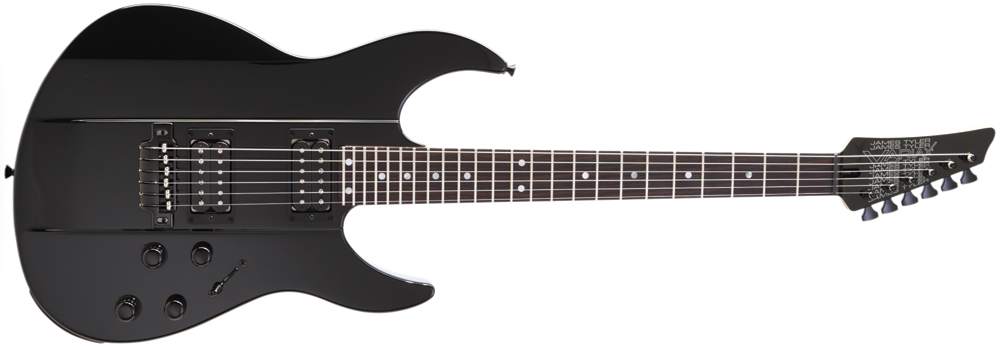Review: Line 6 JTV-59 James Tyler Variax

When Line 6 introduced its Variax technology back in 2003, guitarists were immediately knocked out by its ability to produce the sounds of various guitars and stringed instruments in numerous alternate tunings. However, many players were somewhat lukewarm about the solidbody guitars that housed the technology, which were decent and playable but not particularly sexy.
Line 6 has solved that dilemma in a grand fashion by teaming up with James Tyler Guitars, long known for its boutique electrics favored by numerous L.A. studio guitarists. Line 6 now offers a stunning variety of James Tyler Variax guitars, including a series of high-end U.S. Custom Shop instruments and the more affordable Standard Series. Both series consist of three models: dual- and triple-pickup super-Strat guitars and a Les Paul–style single-cutaway with dual humbuckers. I looked at the Standard Series JTV-59 model, which is based on a Les Paul–style single-cutaway design.
FEATURES
- If you’re familiar with the previous Variax electric guitars, you probably recall that they didn’t have any traditional pickups at all. The James Tyler Variax models all have traditional pickups in addition to Line 6’s Variax technology, so you can plug these guitars into an amp and play them just like any other solidbody. That also means that you have a way to finish playing your gig should you forget to recharge the Variax’s internal lithium-ion battery. (On that note, the battery is a big improvement over the external power supply that came with previous Variax guitars.)
- The JTV-59 has a mahogany body with a carved maple top and flame maple veneer. The set mahogany neck has a rosewood fretboard, 24 9/16–inch scale and 22 medium jumbo frets, and the neck heel is smoothly contoured to provide a seamless transition with the body and deliver incredible playing comfort. The pickups are Tyler’s own vintage-voiced Alnico humbuckers, which are just slightly hotter than traditional PAFs. Controls include individual rotary switches for selecting guitar models and tunings, traditional master volume and master tone knobs, and a three-way pickup selector switch.
The JTV-59’s Variax technology is an improvement of that found on Line 6’s previous Variax solidbody electric guitars, providing new remastered versions of the original 28 instrument models and new pitch-shifting algorithms for the 10 alternate tunings (in addition to standard tuning). You can modify or program your own custom models on a computer using Variax Workbench software (included as a free download) and use them to replace any of the sounds on the model selector knob. Should you prefer not to replace the default models, two custom banks are provided for storing your own models.
The guitar ships with a USB interface and Variax Digital Interface (VDI) cable for connecting the guitar to a computer, POD HD500 or POD HD Pro, but performing guitarists will want to purchase the optional heavy-duty VDI cable that connects the Variax guitar to other Line 6 products, like the POD xt, POD X3 or Vetta II.
PERFORMANCE
The James Tyler Variax guitars provide a considerable upgrade from previous Variax models. The instrument itself is awesome, boasting impeccable workmanship, comfortable playability and classic looks. The JTV-59 plays and sounds great independent of its Variax features, and it’s worth its price just for the guitar alone. This is an ax that most guitarists will have no problems playing as their main guitar all night long.
Get The Pick Newsletter
All the latest guitar news, interviews, lessons, reviews, deals and more, direct to your inbox!
Compared to Variax guitars with five-position switches, the JTV-59, with its three-position pickup selector, presents a few quirks when it comes to accessing instrument models. Although 28 instrument models are available, the model selector switch provides only 10 settings in addition to the two custom settings. On Variax guitars with five-position switches (like the JTV-69 and JTV-89) additional instruments within each setting are accessed at different pickup selector settings, but the JTV-59 often requires a combination of certain pickup settings and pressing down the alternate-tuning knob to access many instruments. It can take a while to memorize each combination, and accessing particular instruments from the JTV-59 isn’t always as instantaneous as it is on the other James Tyler Variax guitars, although if you use certain instruments frequently, you can always assign them to one of the custom settings.
The instrument models sound great, and it’s still a thrill to hear realistic acoustic, resonator, 12-string, banjo, sitar, semihollow, and hollowbody tones coming from a standard solidbody, in addition to all of the solidbody variations. While the stock settings don’t always include all of the possible pickup combinations for certain models, Line 6 really nailed the settings most players need.
THE BOTTOM LINE
Thanks to the incredibly sexy looks and playability of James Tyler’s guitar artistry, using Line 6’s Variax technology is more fun and rewarding than ever.
LIST PRICE $2,099.99
MANUFACTURER Line 6, tylervariax.com
Chris is the co-author of Eruption - Conversations with Eddie Van Halen. He is a 40-year music industry veteran who started at Boardwalk Entertainment (Joan Jett, Night Ranger) and Roland US before becoming a guitar journalist in 1991. He has interviewed more than 600 artists, written more than 1,400 product reviews and contributed to Jeff Beck’s Beck 01: Hot Rods and Rock & Roll and Eric Clapton’s Six String Stories.
“What blew me away was that everyone wanted the curly maple top. People were calling, saying, ‘I’ve got to have the bird inlays’”: Paul Reed Smith on raising the Standard 24, finally cracking the noise-free guitar and why John Sykes is a tone hero
“It combines unique aesthetics with modern playability and impressive tone, creating a Firebird unlike any I’ve had the pleasure of playing before”: Gibson Firebird Platypus review



![[from left] George Harrison with his Gretsch Country Gentleman, Norman Harris of Norman's Rare Guitars holds a gold-top Les Paul, John Fogerty with his legendary 1969 Rickenbacker](https://cdn.mos.cms.futurecdn.net/TuH3nuhn9etqjdn5sy4ntW.jpg)







